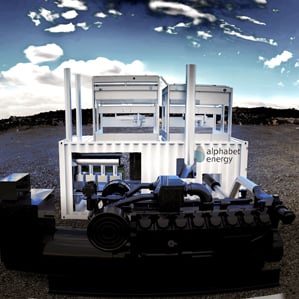An Industrial-Size Generator That Runs on Waste Heat, Using No Fuel
Power plants waste huge amounts of energy as heat—about 40 to 80 percent of the total in the fuel they burn. A new device could reduce that waste, cutting fuel consumption and carbon emissions by as much as 3 percent and saving companies millions of dollars. (Three percent might not seem like much, but for context, air travel accounts for 2 percent of worldwide carbon dioxide emissions.)

The generator makes use of a novel, highly efficient thermoelectric material discovered recently at the University of Michigan (see “Thermoelectric Material to Hit Market Later this Year”). Thermoelectric materials, which convert heat into electricity, have been around for decades, but they have always been too expensive to use outside extreme situations—in spacecraft, for example.
Matt Scullin, the CEO of Alphabet Energy, the startup that developed the new device, says connecting it to the exhaust pipe of a 1,000-kilowatt generator will yield enough electricity to save 52,500 liters of diesel fuel a year, for a reduction of about 2.5 percent. For smaller engines, the savings would be slightly higher, Scullin says.
The first customers will probably be oil, gas, and mining companies that use large generators to produce power in remote areas. The generator could save those companies millions in fuel, Scullin says. “There aren’t many levers these companies can pull to reduce costs that much,” he adds.
Ali Shakouri, a professor of electrical and computer engineering at Purdue University, says the cost savings sound plausible given the material being used, although he hasn’t had a chance to evaluate the technology.
Alphabet Energy’s system is modular, meaning it could be scaled up to make use of larger amounts of waste heat. The company is also developing another thermoelectric material, based on silicon nanowires, that could convert a higher percentage of the energy in waste heat to electricity.
Even improved thermoelectric materials, however, are unlikely to reduce fuel consumption by more than 5 or 10 percent. Other options for making use of waste heat include heating (and even cooling) nearby buildings in cities.
Deep Dive
Climate change and energy
The problem with plug-in hybrids? Their drivers.
Plug-in hybrids are often sold as a transition to EVs, but new data from Europe shows we’re still underestimating the emissions they produce.
Harvard has halted its long-planned atmospheric geoengineering experiment
The decision follows years of controversy and the departure of one of the program’s key researchers.
Why hydrogen is losing the race to power cleaner cars
Batteries are dominating zero-emissions vehicles, and the fuel has better uses elsewhere.
Decarbonizing production of energy is a quick win
Clean technologies, including carbon management platforms, enable the global energy industry to play a crucial role in the transition to net zero.
Stay connected
Get the latest updates from
MIT Technology Review
Discover special offers, top stories, upcoming events, and more.